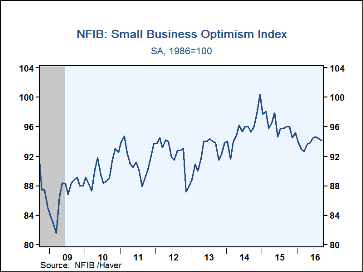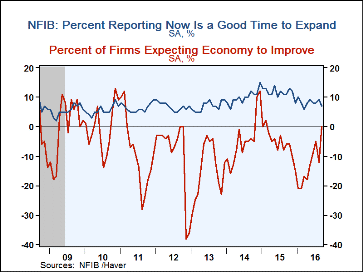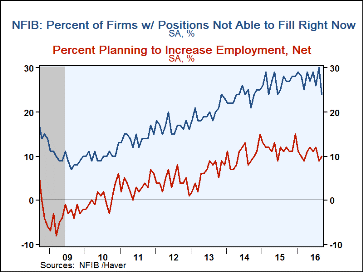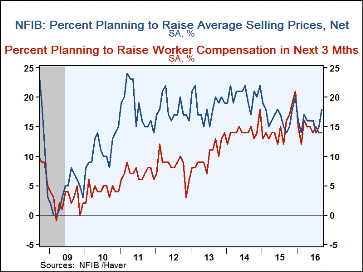 Global| Oct 11 2016
Global| Oct 11 2016U.S. Small Business Optimism Dips Again
by:Tom Moeller
|in:Economy in Brief
Summary
The National Federation of Independent Business reported that its Small Business Optimism Index eased 0.3% during September to 94.1 following an unrevised 0.2% August dip. Optimism remained down 6.2% versus its peak in December 2014. [...]
The National Federation of Independent Business reported that its Small Business Optimism Index eased 0.3% during September to 94.1 following an unrevised 0.2% August dip. Optimism remained down 6.2% versus its peak in December 2014.
A diminished net 7% of firms reported that now was a good time to expend the business. The least percentage (-7%) of firms since February expected credit conditions to ease. The percent planning to add to inventories fell sharply. The percentage planning to raise capital spending eased to the lowest point in six months. To the upside, the percentage of firms expecting the economy to improve rose to the highest level since January 2015. An improved 4%, the best this year, were expecting higher real sales in six months. An increased -20% of firms expected higher real earnings this quarter.
A slightly higher ten percent of firms expected to increase employment. A steady 48% of respondents found few or no qualified candidates to fill job openings, but that remained at the cycle high. A greatly diminished 24% of firms had positions they were not able to fill right now, the least since June of last year. A diminished 22% of firms raised worker compensation over the last three months, while a stable 14% were expecting to raise it in the next three months.
Small businesses' pricing ability deteriorated as a net 1% of firms were lowering prices. Expectations about the future ability to raise prices, however, jumped to 18%, the highest percentage since December.
A slightly increased five percent of firms reported that credit was tougher to get, up from three percent in October. A sharply increased 32% of firms felt satisfied that their borrowing needs had been filled in the last three months.
Twenty two percent of firms indicated that taxes were the single most important problem, the most in three months. A reduced 17% reported that government requirements were the largest single problem. A higher 17% felt challenged by the quality of labor, and a higher 13% of firms indicated that poor sales were the largest single problem. A reduced six percent reported the cost of labor was the biggest problem. A lessened seven percent reported insurance cost & availability as the largest hurdle, down from 10% in April. An increased eight percent reported competition from large businesses as the largest problem. Inflation was indicated by a stable two percent of respondents as the largest problem, down from four percent in May.
Roughly 24 million small businesses exist in the U.S. and they create 80% of all new jobs. The typical NFIB member employs 10 people and reports gross sales of about $500,000 a year. The NFIB figures can be found in Haver's SURVEYS database.
The U.S. Economy and Monetary Policy by Fed Vice Chairman Stanley Fischer can be found here.
| National Federation of Independent Business (SA, Net %) | Sep | Aug | Jul | Sep'15 | 2015 | 2014 | 2013 |
|---|---|---|---|---|---|---|---|
| Small Business Optimism Index (1986=100) | 94.1 | 94.4 | 94.6 | 96.0 | 96.1 | 95.6 | 92.4 |
| Firms Reporting Now is a Good Time To Expand the Business | 7 | 9 | 8 | 11 | 11 | 10 | 7 |
| Firms Expecting Higher Real Sales In Six Months | 4 | -1 | 1 | 2 | 8 | 11 | 4 |
| Firms Expecting Economy To Improve | 0 | -12 | -5 | -6 | -5 | -5 | -15 |
| Firms Planning to Increase Employment | 10 | 9 | 12 | 11 | 12 | 10 | 6 |
| Firms With Few or No Qualified Applicants For Job Openings | 48 | 48 | 46 | 45 | 46 | 43 | 39 |
| Firms Reporting That Credit Was Harder To Get | 5 | 4 | 4 | 4 | 4 | 6 | 6 |
| Firms Raising Average Selling Prices | -1 | 3 | -2 | 1 | 2 | 8 | 2 |
| Firms Raising Worker Compensation | 22 | 24 | 24 | 23 | 23 | 21 | 15 |
Tom Moeller
AuthorMore in Author Profile »Prior to joining Haver Analytics in 2000, Mr. Moeller worked as the Economist at Chancellor Capital Management from 1985 to 1999. There, he developed comprehensive economic forecasts and interpreted economic data for equity and fixed income portfolio managers. Also at Chancellor, Mr. Moeller worked as an equity analyst and was responsible for researching and rating companies in the economically sensitive automobile and housing industries for investment in Chancellor’s equity portfolio. Prior to joining Chancellor, Mr. Moeller was an Economist at Citibank from 1979 to 1984. He also analyzed pricing behavior in the metals industry for the Council on Wage and Price Stability in Washington, D.C. In 1999, Mr. Moeller received the award for most accurate forecast from the Forecasters' Club of New York. From 1990 to 1992 he was President of the New York Association for Business Economists. Mr. Moeller earned an M.B.A. in Finance from Fordham University, where he graduated in 1987. He holds a Bachelor of Arts in Economics from George Washington University.










